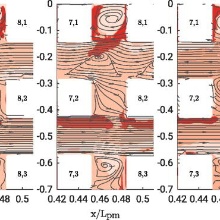New SFB 1313 Publication (University of Stuttgart), published in Physics of Fluids (AIP Publishing). The work has been developed within the SFB 1313 research project A06.
Authors
- Julian Härter (University of Stuttgart, SFB 1313 research project A06)
- David Sebastián Martínez Hernández (Universidad Politecnica de Cartagena, former SFB 1313 researcher, task force "experiments")
- Rico Poser (University of Stuttgart, research project A06)
- Bernhard Weigand (University of Stuttgart, research project A02)
- Grazia Lamanna (University of Stuttgart, research project A06, project MGK)
Abstract
The existence of large-scale turbulent structures within a porous medium, generated through the interaction with a turbulent outer flow, is a highly debated topic, albeit most of the analysis is based on computational studies. This study contributes to the ongoing discussion by providing detailed point-measurements of the velocity in both regions by means of Particle Image Velocimetry (PIV). Two porous models of different porosity are investigated at three Reynolds numbers. The design of the experiments is based on theoretical studies to guarantee the presence of an unperturbed viscous layer at the interface (alias permeability Reynolds numbers of order one). Under these conditions and in compliance with theoretical predictions, the PIV data show the rapid dumping of turbulent fluctuations within the first pore cavities and can be used to validate closure models for volume-averaged computational studies. A point-data analysis is applied in the interfacial region by requiring continuity of tangential velocity and shear stress. The presence of the attached viscous layer implies that the coupling condition for momentum transfer must be controlled by shear, leading to the well-known Beavers and Joseph coupling condition. PIV data corroborate this statement and show the close interdependency between the penetration depth of the outer flow in the porous media and the characteristics of the vortical secondary flows induced by the strain rate at the pore scale. Consequently, the Beavers and Joseph-slip coefficient depends only upon the topology of the porous medium, at least as long as no transition to a perturbed mixing layer occurs at the interface.

Julian Härter
Doctoral Researcher, Research Project A06

David Sebastián Martínez Hernández
PhDPostdoctoral Researcher, Task Force "Experiments"

Rico Poser
Dr.-Ing.Principal Investigator, Research Project A06


